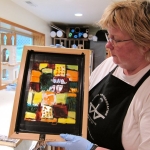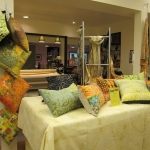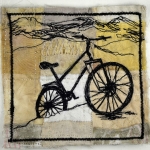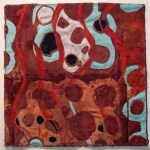This past weekend we finally had our first 80 degree day so I decided to take advantage of the warm weather and dye some fabric. Mostly I just needed a non-verbal day to relax and be by myself, with no pressure of deadlines or deliverables and I was just really wanting to play with color. I have some ideas about new textile paintings I want to start, but I needed some play time and this was my answer.
I used the low water immersion dyeing process, loosely following the process Ann Johnston describes in her book, Color by Accident. My friend Lisa Call taught me her version of this process last summer so now I’m trying out what I learned from Lisa on my own and will eventually pass on what I’ve learned to other artists as well. I love our artists’ community of learning and teaching each other new things.
I like this process because, even though you can start with a general idea of colors that you want to achieve, you never know quite what colors you’ll end up with (unless you are a control freak and painstakingly measure and write down all your dye recipes, which I have no interest in doing). This makes it fun and interesting. It also virtually guarantees that you’ll never get the same exact fabric color twice. This appeals to me much the same way as making original art does and reminds me of something I was taught in a beginning painting class years ago – that it is preferable each time you put your brush back to the palette, to attempt to load it with a different combination of paint. That way, you always have more interesting variation of color on your canvas, even if you’re painting a large area of a (seemingly) single color.
By layering up to 3 or 4 pieces of fabric in each tub, you end up getting a range of values of a single color, as each successive layer is lighter in value because there are less and less dye molecules left in the dye bath to be absorbed with each layer of fabric added. Mixing the dyes to get an interesting starting color and then watching what happens as the dyes change in color as each successive layer of fabric is added, is is a fun way to learn about color theory and dye properties. In the photo below, you can see how the layers of fabric in each tub get lighter successively.
Although I had fun, I kind of forgot just how much work it is to dye 60+ yards of fabric! I’m still really glad I did it, but it turned into an all weekend and into Monday am project before I was “finished” (technically I’m not really finished, as I haven’t yet ironed all of this fabric just yet).










Ayn Hanna this is so cool to see how and why you love dying your own fabric. I get it now! Thanks for the peek into your world! B